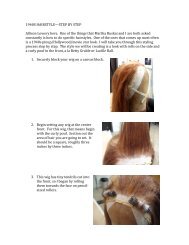Suite 8 - Focal Press: Book companions
Suite 8 - Focal Press: Book companions
Suite 8 - Focal Press: Book companions
You also want an ePaper? Increase the reach of your titles
YUMPU automatically turns print PDFs into web optimized ePapers that Google loves.
Figure 1.2 Analog Display.<br />
<strong>Suite</strong> 8<br />
outer lining areas of the interface that surrounds the display. Each has dedicated<br />
selectable parameters. In the center area of the interface is the instrument<br />
parameter display, which shows currently selected shell parameter settings, and<br />
updates as different shell parameters are selected.<br />
For example, when Analog’s Osc1 section is selected, its parameters will be visible<br />
in the display. Click on an individual shell section to bring up its parameters<br />
at any time. As with analog synthesizers, these parameters are routable to Analog’s<br />
filter section and other parameters including the amplifier, providing many<br />
sound-shaping options. It is also possible to route its oscillator signal or signals<br />
in series or in parallel, allowing you to create big sounding instruments that will<br />
inspire further interest into the sound-shaping world of synthesis.<br />
The individual shell’s window will turn from gray to white when selected. You<br />
can see what we mean by clicking on the various shell sections located around<br />
the outside of the central display area found in the middle.<br />
Figure 1.3 Analog Oscillator shell section.<br />
Each oscillator can be used independently or in conjunction with the other.<br />
Analog also has an incredible amount of routing flexibility in regards to both<br />
the balance and filtering of the oscillator’s sound. You’ll find a shape chooser<br />
window that displays Analog’s four oscillator waveform types: Sine, Sawtooth,<br />
Rectangular, and Noise. Part of Analog’s implementation is designed around<br />
what Ableton calls “routing schemes.” These routing parameter schemes are<br />
preset, ready to load, and are specific to the oscillator, filter, and amp. They can<br />
be found in the display area by clicking on the global volume shell on the far<br />
right side of the interface. The onboard filters, LFO’s, pitch/filter envelopes, and<br />
multiple tuning parameters make sound design and patch creation a lot of fun<br />
and addictive once you get the hang of it all.<br />
5



